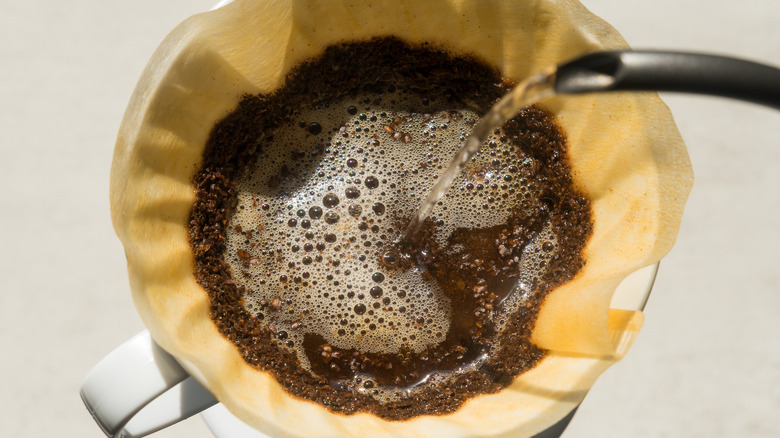How High To Hold The Kettle For A Successful Pour-Over Coffee
As its name suggests, pouring technique is everything when it comes to brewing pour-over coffee. Choosing the right beans and grind is an important start, but whether or not you're able to extract the coffee in a consistent and timely manner is entirely dependent on how you pour the water. Not only do you have to pay careful attention to how fast you're pouring, but you also need to watch for how high you're holding the kettle: Too high or too low can result in inconsistent extraction and an underwhelming flavor, so you'll want to find the right balance to get the most out of your coffee.
It all comes down to how much agitation you're introducing to the coffee bed. In general, a good amount of agitation in your coffee will make sure that all the grounds are exposed to the water at an even rate without any stagnating sections or water channels. However, too much agitation can also force the micro-grounds into the pores of the filter, clogging it up and slowing down the brew time by quite a bit. By extension, the coffee becomes over-extracted while the water passes through much more slowly, making it taste far too dark and astringent. For the best results, you want a good balance that will consistently break up the coffee bed without clogging the filter. Blue Bottle Coffee Lab recommends pouring from 8 to 10 inches above the coffee, but your results may vary depending on your grind size, roast darkness, and brewer type.
Figuring out your perfect pour height
Unfortunately, pour-over coffee is still an inexact science that largely depends on individual taste and preference. While 8 to 10 inches is a good guideline, there is no hard-and-fast standard that can tell you which pouring height works best for any given kind of coffee or brewer. But thankfully, there are a few key aspects to understand that'll help you conduct some informed experiments on your way to perfecting your personal pouring technique.
First off, lighter coffees extract much more slowly and benefit from a higher pour that agitates the coffee bed and gives a more consistent brew. Darker roasts, on the other hand, are prone to coming out too bitter and should only be agitated enough to get an even soak on the grounds without drawing out the brewing time. Grind size also has a huge effect: The coarser the coffee, the slower it'll extract.
Another thing to keep in mind is the type of pour-over brewer you have. The most common kind on the market is the bee house brewer. Because of its slow flow rate, you should probably err on the side of a lower pour height to avoid over-brewing your coffee. But faster brewers like the V60 can benefit from a higher pour that introduces a good amount of agitation before the water flows through. Keeping flow rate and extraction speed in mind, make sure to mix and match deliberate choices in brewer, coffee, and pour height for successful pour-over brews.

